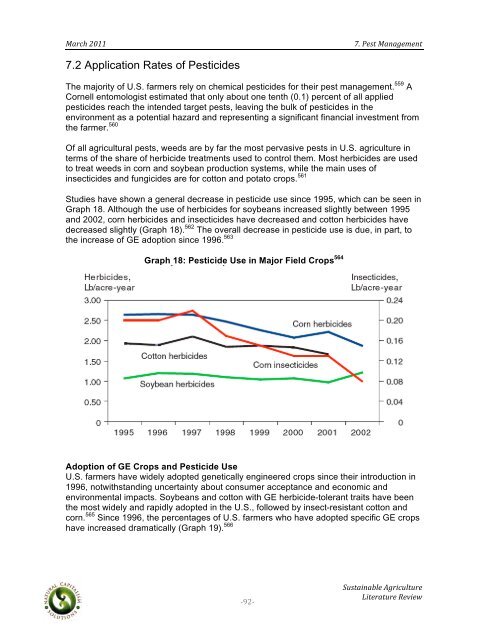Sustainable Agriculture Literature Review - Boulder County
Sustainable Agriculture Literature Review - Boulder County
Sustainable Agriculture Literature Review - Boulder County
You also want an ePaper? Increase the reach of your titles
YUMPU automatically turns print PDFs into web optimized ePapers that Google loves.
! ! !!<br />
"#$%&!'())!! !!!!!!!!!!!!!!!!!!!!!!!!!!!!!!!!!!!!!!!!!!!!!!!!!!!!!!!!!!!!!!!!@+!A142!"#5#81B152!<br />
7.2 Application Rates of Pesticides<br />
The majority of U.S. farmers rely on chemical pesticides for their pest management. 559 A<br />
Cornell entomologist estimated that only about one tenth (0.1) percent of all applied<br />
pesticides reach the intended target pests, leaving the bulk of pesticides in the<br />
environment as a potential hazard and representing a significant financial investment from<br />
the farmer. 560<br />
Of all agricultural pests, weeds are by far the most pervasive pests in U.S. agriculture in<br />
terms of the share of herbicide treatments used to control them. Most herbicides are used<br />
to treat weeds in corn and soybean production systems, while the main uses of<br />
insecticides and fungicides are for cotton and potato crops. 561<br />
Studies have shown a general decrease in pesticide use since 1995, which can be seen in<br />
Graph 18. Although the use of herbicides for soybeans increased slightly between 1995<br />
and 2002, corn herbicides and insecticides have decreased and cotton herbicides have<br />
decreased slightly (Graph 18). 562 The overall decrease in pesticide use is due, in part, to<br />
the increase of GE adoption since 1996. 563<br />
!<br />
Graph 18: Pesticide Use in Major Field Crops 564<br />
Adoption of GE Crops and Pesticide Use<br />
U.S. farmers have widely adopted genetically engineered crops since their introduction in<br />
1996, notwithstanding uncertainty about consumer acceptance and economic and<br />
environmental impacts. Soybeans and cotton with GE herbicide-tolerant traits have been<br />
the most widely and rapidly adopted in the U.S., followed by insect-resistant cotton and<br />
corn. 565 Since 1996, the percentages of U.S. farmers who have adopted specific GE crops<br />
have increased dramatically (Graph 19). 566<br />
"$("<br />
!,342#.5#6/1!78$.%3/23$1!<br />
9.21$#23$1!:1;.1
















